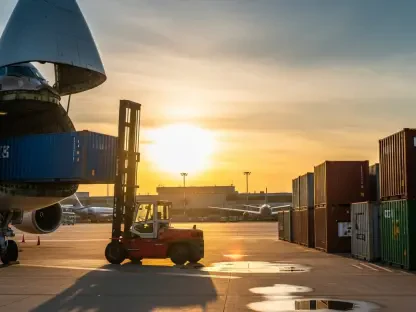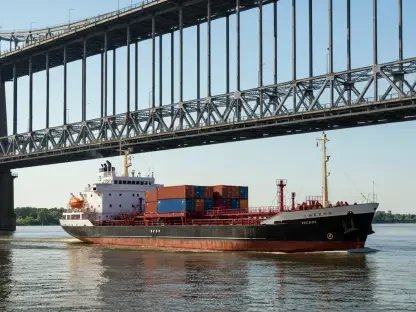Overview of a Disrupted Landscape
The European shipping industry stands at a critical juncture, grappling with unprecedented supply chain disruptions that have rippled across economies, affecting trade and commerce on a massive scale. A staggering 80% of cargo owners surveyed among over 900 companies anticipate these challenges persisting until at least 2027, painting a stark picture of an industry under immense strain. From geopolitical tensions to fluctuating trade tariffs, the hurdles are multifaceted, threatening the stability of a sector that underpins much of Europe’s economic framework. This report delves into the heart of these disruptions, exploring how shippers are navigating chaos and forging paths to resilience.
The significance of shipping in Europe cannot be overstated, as it serves as a lifeline for trade and commerce, connecting markets and sustaining industries. Major players in this space, alongside countless smaller operators, contribute to a sector that drives billions in economic activity annually. Yet, the current environment is marked by uncertainty, with external forces compounding operational difficulties and testing the endurance of even the most established firms.
Deep Dive into Supply Chain Challenges
Persistent Disruptions and Industry Concerns
Survey results reveal a pervasive unease among European cargo owners, with a significant 78% citing geopolitical issues as a primary concern for the coming years. This anxiety is compounded by other pressing factors, including higher import and export costs affecting 46% of respondents, trade tariffs impacting 43%, and policy uncertainty troubling 40%. These elements collectively create a volatile landscape where planning and execution become increasingly complex.
The ramifications of these disruptions are profound, with 80% of surveyed companies reporting that supply chain issues are directly hindering business growth. This statistic underscores the urgency for adaptive strategies as firms grapple with escalating costs and operational bottlenecks. The consensus among industry stakeholders points to a prolonged period of instability, necessitating immediate and innovative responses to safeguard profitability.
Unlike mere operational hiccups, these challenges represent systemic threats to the industry’s future. Companies are not just facing temporary setbacks but are contending with a shifting global order that demands a reevaluation of traditional practices. The focus now shifts to how these pain points can inform strategic overhauls in the face of enduring uncertainty.
Market Outlook and Expectations
Looking ahead, the survey of over 900 European companies projects that supply chain chaos will remain a dominant force, with most expecting severe disruptions to linger for at least two more years. This forecast shapes a cautious outlook, where long-term planning becomes a delicate balance between risk management and seizing opportunities. The data suggests a critical need for forward-thinking approaches to mitigate the impact of an unpredictable global environment.
Beyond immediate concerns, the evolving nature of international trade dynamics is poised to further influence European shipping. Projections indicate that geopolitical shifts and regulatory changes will continue to challenge operational norms, pushing companies to rethink supply chain configurations. This environment fosters a mindset of preparedness, where anticipating change becomes as crucial as reacting to it.
The broader implications of these expectations are evident in how businesses are beginning to prioritize resilience over short-term gains. As the industry braces for ongoing volatility, the emphasis on strategic foresight is clear, with many firms recalibrating their approaches to align with a more turbulent future. This shift signals a maturing perspective on navigating systemic risks in a connected world.
Obstacles on the Horizon
Geopolitical tensions stand as a formidable barrier for European shippers, creating a ripple effect that disrupts trade flows and escalates operational uncertainties. Alongside this, fluctuating trade tariffs introduce additional financial burdens, often catching businesses off guard with sudden cost spikes. Unpredictable global regulations further complicate the landscape, making compliance a moving target for many operators.
The direct impact on operations manifests as increased costs and stunted growth, with firms struggling to maintain margins under mounting pressures. Delays at key transit points and unexpected policy shifts exacerbate these issues, leading to inefficiencies that erode competitive edges. The cumulative effect is a sector under duress, compelled to find new ways to stabilize amidst constant change.
Mitigating these risks requires a blend of agility and proactive measures, as shippers explore options to cushion against sudden shocks. Strategies such as building buffer inventories or investing in predictive analytics are gaining traction as means to anticipate disruptions. The focus is on creating flexible frameworks that allow for rapid pivots when external conditions shift unexpectedly.
Navigating Regulatory and Policy Shifts
Global trade policies and abrupt tariff changes play a pivotal role in fostering uncertainty for European shippers, often leaving them scrambling to adjust. These regulatory fluctuations can alter cost structures overnight, demanding a high degree of adaptability from businesses striving to remain compliant. The unpredictability of such shifts poses a persistent challenge to maintaining seamless operations.
Compliance, therefore, emerges as a cornerstone of navigating this complex terrain, with companies investing in expertise and systems to stay ahead of regulatory curves. The ability to swiftly interpret and act on policy changes can mean the difference between disruption and continuity. This necessitates a culture of vigilance, where staying informed is as critical as operational execution.
Insights from industry experts, such as Lars Karlsson, Global Head of Trade & Customs Consulting at Maersk, highlight the value of equipped strategies in managing unforeseen policy impacts. Karlsson emphasizes that having the right tools and frameworks enables firms to respond effectively to sudden changes, reducing the sting of regulatory surprises. Such perspectives reinforce the need for robust systems to handle the intricacies of global trade rules.
Building Resilience for Tomorrow
Emerging trends in supply chain resilience point to a strategic pivot among European shippers, with 75% of survey respondents diversifying sourcing to spread risk across multiple regions. An equal percentage are exploring alternative trade routes to bypass chokepoints and mitigate disruption impacts. These approaches signify a departure from reliance on single pathways, aiming for broader operational stability.
Strengthening logistics partnerships is another focal point, with 80% of companies prioritizing closer ties with suppliers and service providers to ensure reliability. Meanwhile, 60% are channeling resources into enhancing operational transparency and flexibility, recognizing visibility as a key to managing uncertainty. These investments reflect a commitment to creating adaptable networks capable of withstanding external pressures.
Industry leaders like Aymeric Chandavoine, President of Europe at Maersk, advocate for the development of smarter, more resilient supply chains to support long-term growth. Chandavoine stresses that building interconnected systems designed for agility can transform challenges into opportunities for expansion. This vision aligns with the industry’s broader push toward innovation as a cornerstone of enduring success.
Final Reflections and Path Ahead
Reflecting on the insights gathered, it is evident that European shippers face a landscape defined by persistent disruptions, with geopolitical and regulatory challenges at the forefront of their struggles. The comprehensive survey of over 900 companies paints a picture of an industry under siege, yet determined to adapt through strategic resilience. The depth of concern over ongoing volatility is matched by a proactive drive to overhaul traditional practices.
Moving forward, the actionable step for shippers is to deepen investments in diversification and technology, ensuring that supply chains can pivot swiftly in response to global shifts. Building on the momentum of stronger partnerships proves vital, as collaboration emerges as a linchpin for stability in turbulent times. These efforts are seen as critical to not just surviving but thriving amidst uncertainty.
The future consideration for the industry centers on sustaining this adaptive mindset, with an emphasis on continuous learning and innovation to preempt emerging risks. By fostering a culture of preparedness and leveraging expert insights, European shippers position themselves to turn systemic challenges into competitive advantages. This forward-looking stance is the key takeaway, guiding the sector toward a more robust tomorrow.









